University Report: Reflective and Pedagogical Practices Continuity
VerifiedAdded on 2023/06/07
|6
|1951
|256
Report
AI Summary
This report delves into the pedagogy of continuity, focusing on the critical transition of children from early childhood education (ECEC) to primary schools. It explores the importance of aligning ECEC centers and primary schools to enhance children's literacy and math skills, while also addressing the impact of these transitions on children's experiences and development. The report analyzes various studies on pedagogy continuity, including the role of home and childcare services, refugee children's experiences, cultural negotiation, and the perspectives of teachers. It emphasizes the need for consistency in primary care practices, the impact of multiple caregivers, and the importance of considering factors such as behavior, sleep, and hygiene. The report also examines the challenges faced by refugee families, the significance of incorporating cultural contexts in childhood development, and the need for designing programs and policies that support continuity of care. It concludes by highlighting the crucial role of continuity of care during childhood development to enhance children's overall development and well-being.
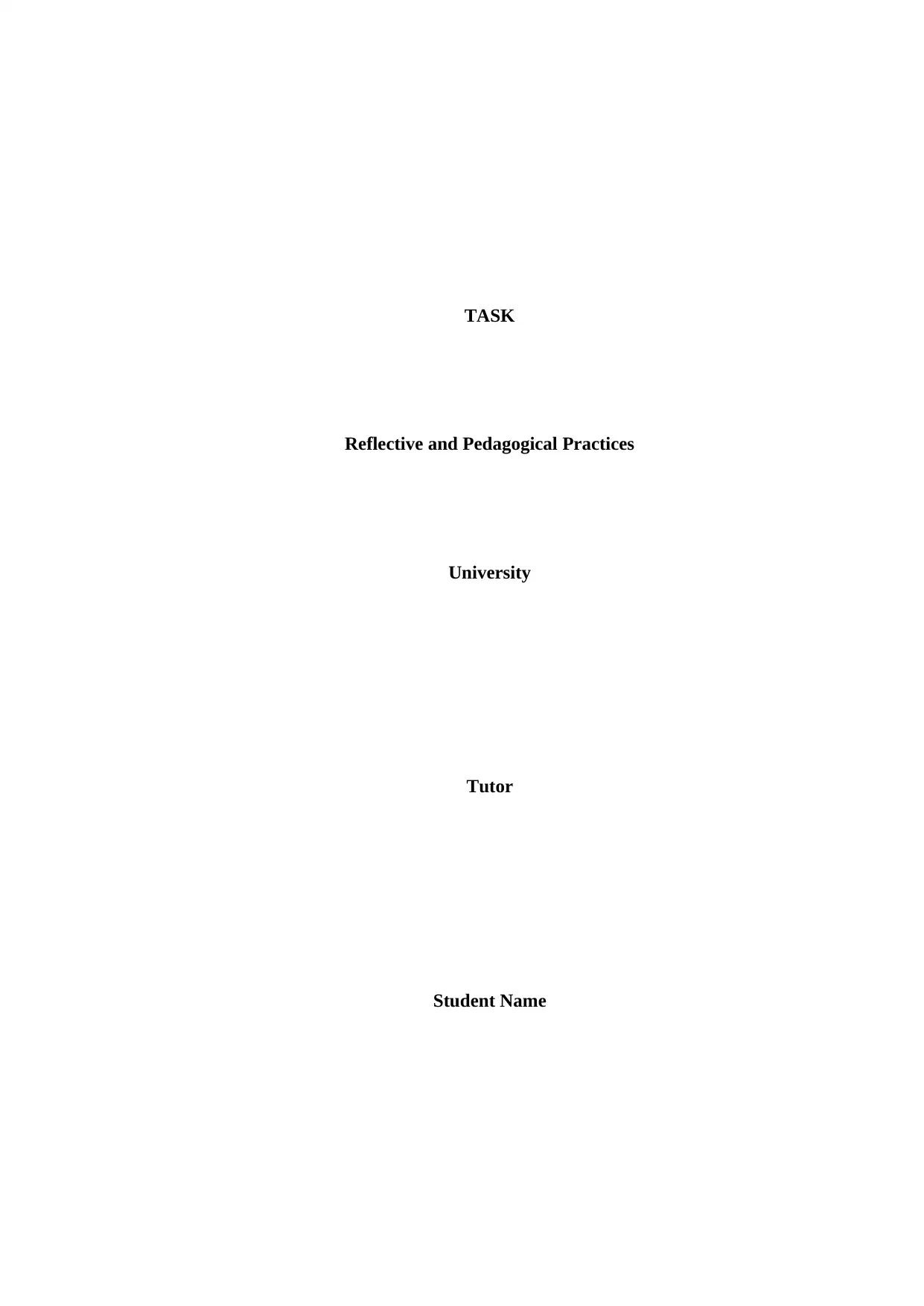
TASK
Reflective and Pedagogical Practices
University
Tutor
Student Name
Reflective and Pedagogical Practices
University
Tutor
Student Name
Paraphrase This Document
Need a fresh take? Get an instant paraphrase of this document with our AI Paraphraser
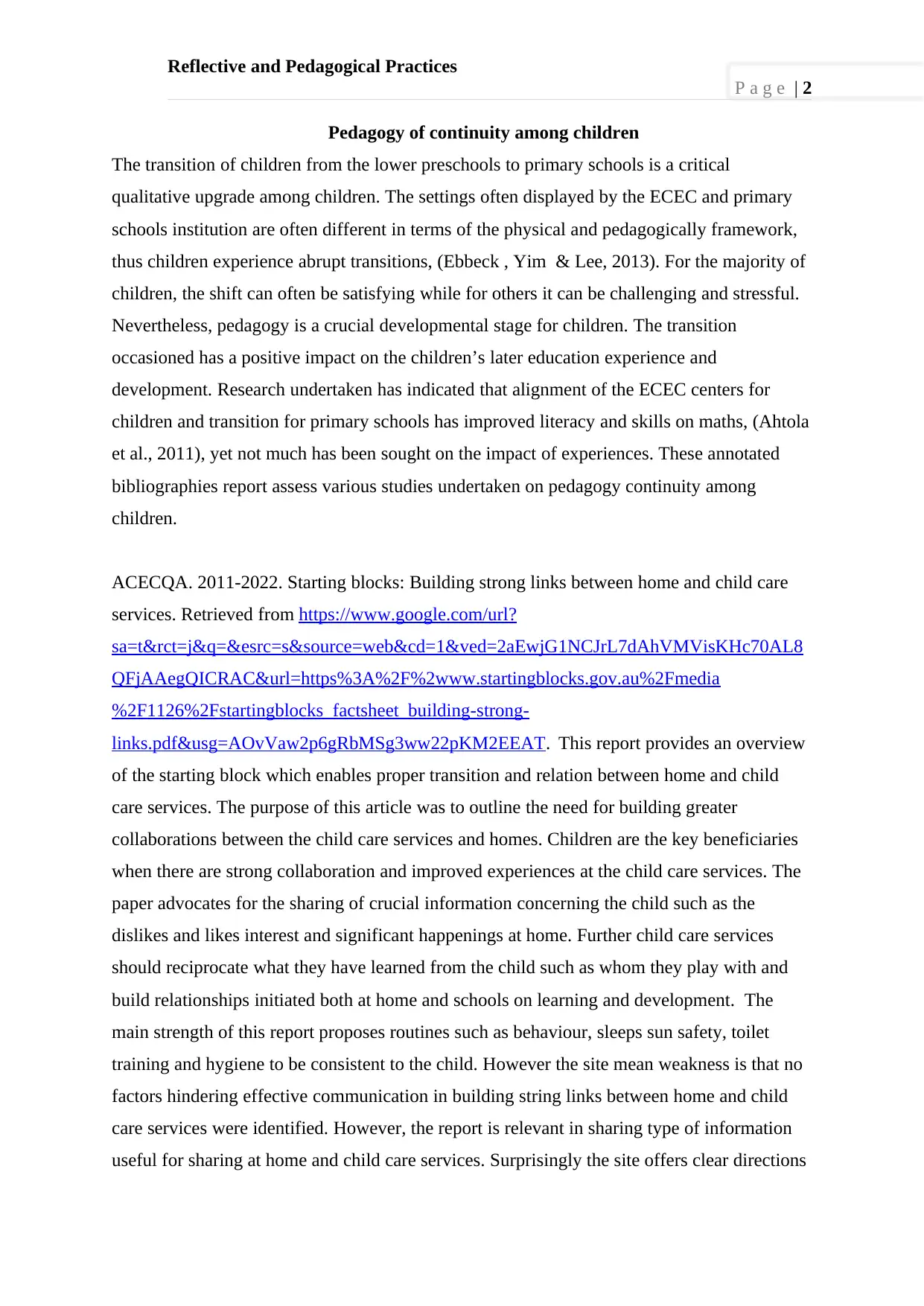
Reflective and Pedagogical Practices
P a g e | 2
Pedagogy of continuity among children
The transition of children from the lower preschools to primary schools is a critical
qualitative upgrade among children. The settings often displayed by the ECEC and primary
schools institution are often different in terms of the physical and pedagogically framework,
thus children experience abrupt transitions, (Ebbeck , Yim & Lee, 2013). For the majority of
children, the shift can often be satisfying while for others it can be challenging and stressful.
Nevertheless, pedagogy is a crucial developmental stage for children. The transition
occasioned has a positive impact on the children’s later education experience and
development. Research undertaken has indicated that alignment of the ECEC centers for
children and transition for primary schools has improved literacy and skills on maths, (Ahtola
et al., 2011), yet not much has been sought on the impact of experiences. These annotated
bibliographies report assess various studies undertaken on pedagogy continuity among
children.
ACECQA. 2011-2022. Starting blocks: Building strong links between home and child care
services. Retrieved from https://www.google.com/url?
sa=t&rct=j&q=&esrc=s&source=web&cd=1&ved=2aEwjG1NCJrL7dAhVMVisKHc70AL8
QFjAAegQICRAC&url=https%3A%2F%2www.startingblocks.gov.au%2Fmedia
%2F1126%2Fstartingblocks_factsheet_building-strong-
links.pdf&usg=AOvVaw2p6gRbMSg3ww22pKM2EEAT. This report provides an overview
of the starting block which enables proper transition and relation between home and child
care services. The purpose of this article was to outline the need for building greater
collaborations between the child care services and homes. Children are the key beneficiaries
when there are strong collaboration and improved experiences at the child care services. The
paper advocates for the sharing of crucial information concerning the child such as the
dislikes and likes interest and significant happenings at home. Further child care services
should reciprocate what they have learned from the child such as whom they play with and
build relationships initiated both at home and schools on learning and development. The
main strength of this report proposes routines such as behaviour, sleeps sun safety, toilet
training and hygiene to be consistent to the child. However the site mean weakness is that no
factors hindering effective communication in building string links between home and child
care services were identified. However, the report is relevant in sharing type of information
useful for sharing at home and child care services. Surprisingly the site offers clear directions
P a g e | 2
Pedagogy of continuity among children
The transition of children from the lower preschools to primary schools is a critical
qualitative upgrade among children. The settings often displayed by the ECEC and primary
schools institution are often different in terms of the physical and pedagogically framework,
thus children experience abrupt transitions, (Ebbeck , Yim & Lee, 2013). For the majority of
children, the shift can often be satisfying while for others it can be challenging and stressful.
Nevertheless, pedagogy is a crucial developmental stage for children. The transition
occasioned has a positive impact on the children’s later education experience and
development. Research undertaken has indicated that alignment of the ECEC centers for
children and transition for primary schools has improved literacy and skills on maths, (Ahtola
et al., 2011), yet not much has been sought on the impact of experiences. These annotated
bibliographies report assess various studies undertaken on pedagogy continuity among
children.
ACECQA. 2011-2022. Starting blocks: Building strong links between home and child care
services. Retrieved from https://www.google.com/url?
sa=t&rct=j&q=&esrc=s&source=web&cd=1&ved=2aEwjG1NCJrL7dAhVMVisKHc70AL8
QFjAAegQICRAC&url=https%3A%2F%2www.startingblocks.gov.au%2Fmedia
%2F1126%2Fstartingblocks_factsheet_building-strong-
links.pdf&usg=AOvVaw2p6gRbMSg3ww22pKM2EEAT. This report provides an overview
of the starting block which enables proper transition and relation between home and child
care services. The purpose of this article was to outline the need for building greater
collaborations between the child care services and homes. Children are the key beneficiaries
when there are strong collaboration and improved experiences at the child care services. The
paper advocates for the sharing of crucial information concerning the child such as the
dislikes and likes interest and significant happenings at home. Further child care services
should reciprocate what they have learned from the child such as whom they play with and
build relationships initiated both at home and schools on learning and development. The
main strength of this report proposes routines such as behaviour, sleeps sun safety, toilet
training and hygiene to be consistent to the child. However the site mean weakness is that no
factors hindering effective communication in building string links between home and child
care services were identified. However, the report is relevant in sharing type of information
useful for sharing at home and child care services. Surprisingly the site offers clear directions
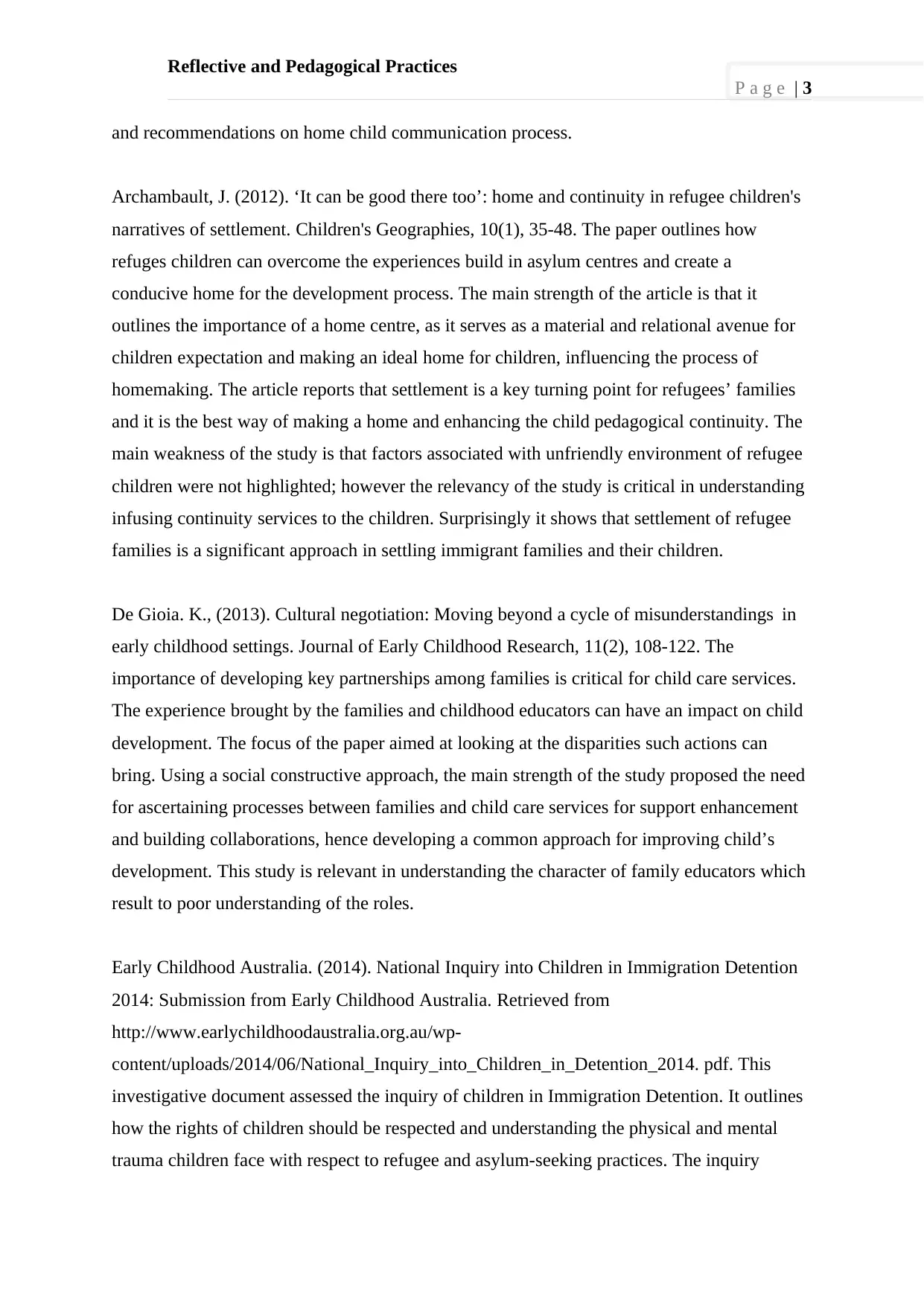
Reflective and Pedagogical Practices
P a g e | 3
and recommendations on home child communication process.
Archambault, J. (2012). ‘It can be good there too’: home and continuity in refugee children's
narratives of settlement. Children's Geographies, 10(1), 35-48. The paper outlines how
refuges children can overcome the experiences build in asylum centres and create a
conducive home for the development process. The main strength of the article is that it
outlines the importance of a home centre, as it serves as a material and relational avenue for
children expectation and making an ideal home for children, influencing the process of
homemaking. The article reports that settlement is a key turning point for refugees’ families
and it is the best way of making a home and enhancing the child pedagogical continuity. The
main weakness of the study is that factors associated with unfriendly environment of refugee
children were not highlighted; however the relevancy of the study is critical in understanding
infusing continuity services to the children. Surprisingly it shows that settlement of refugee
families is a significant approach in settling immigrant families and their children.
De Gioia. K., (2013). Cultural negotiation: Moving beyond a cycle of misunderstandings in
early childhood settings. Journal of Early Childhood Research, 11(2), 108-122. The
importance of developing key partnerships among families is critical for child care services.
The experience brought by the families and childhood educators can have an impact on child
development. The focus of the paper aimed at looking at the disparities such actions can
bring. Using a social constructive approach, the main strength of the study proposed the need
for ascertaining processes between families and child care services for support enhancement
and building collaborations, hence developing a common approach for improving child’s
development. This study is relevant in understanding the character of family educators which
result to poor understanding of the roles.
Early Childhood Australia. (2014). National Inquiry into Children in Immigration Detention
2014: Submission from Early Childhood Australia. Retrieved from
http://www.earlychildhoodaustralia.org.au/wp-
content/uploads/2014/06/National_Inquiry_into_Children_in_Detention_2014. pdf. This
investigative document assessed the inquiry of children in Immigration Detention. It outlines
how the rights of children should be respected and understanding the physical and mental
trauma children face with respect to refugee and asylum-seeking practices. The inquiry
P a g e | 3
and recommendations on home child communication process.
Archambault, J. (2012). ‘It can be good there too’: home and continuity in refugee children's
narratives of settlement. Children's Geographies, 10(1), 35-48. The paper outlines how
refuges children can overcome the experiences build in asylum centres and create a
conducive home for the development process. The main strength of the article is that it
outlines the importance of a home centre, as it serves as a material and relational avenue for
children expectation and making an ideal home for children, influencing the process of
homemaking. The article reports that settlement is a key turning point for refugees’ families
and it is the best way of making a home and enhancing the child pedagogical continuity. The
main weakness of the study is that factors associated with unfriendly environment of refugee
children were not highlighted; however the relevancy of the study is critical in understanding
infusing continuity services to the children. Surprisingly it shows that settlement of refugee
families is a significant approach in settling immigrant families and their children.
De Gioia. K., (2013). Cultural negotiation: Moving beyond a cycle of misunderstandings in
early childhood settings. Journal of Early Childhood Research, 11(2), 108-122. The
importance of developing key partnerships among families is critical for child care services.
The experience brought by the families and childhood educators can have an impact on child
development. The focus of the paper aimed at looking at the disparities such actions can
bring. Using a social constructive approach, the main strength of the study proposed the need
for ascertaining processes between families and child care services for support enhancement
and building collaborations, hence developing a common approach for improving child’s
development. This study is relevant in understanding the character of family educators which
result to poor understanding of the roles.
Early Childhood Australia. (2014). National Inquiry into Children in Immigration Detention
2014: Submission from Early Childhood Australia. Retrieved from
http://www.earlychildhoodaustralia.org.au/wp-
content/uploads/2014/06/National_Inquiry_into_Children_in_Detention_2014. pdf. This
investigative document assessed the inquiry of children in Immigration Detention. It outlines
how the rights of children should be respected and understanding the physical and mental
trauma children face with respect to refugee and asylum-seeking practices. The inquiry
You're viewing a preview
Unlock full access by subscribing today!
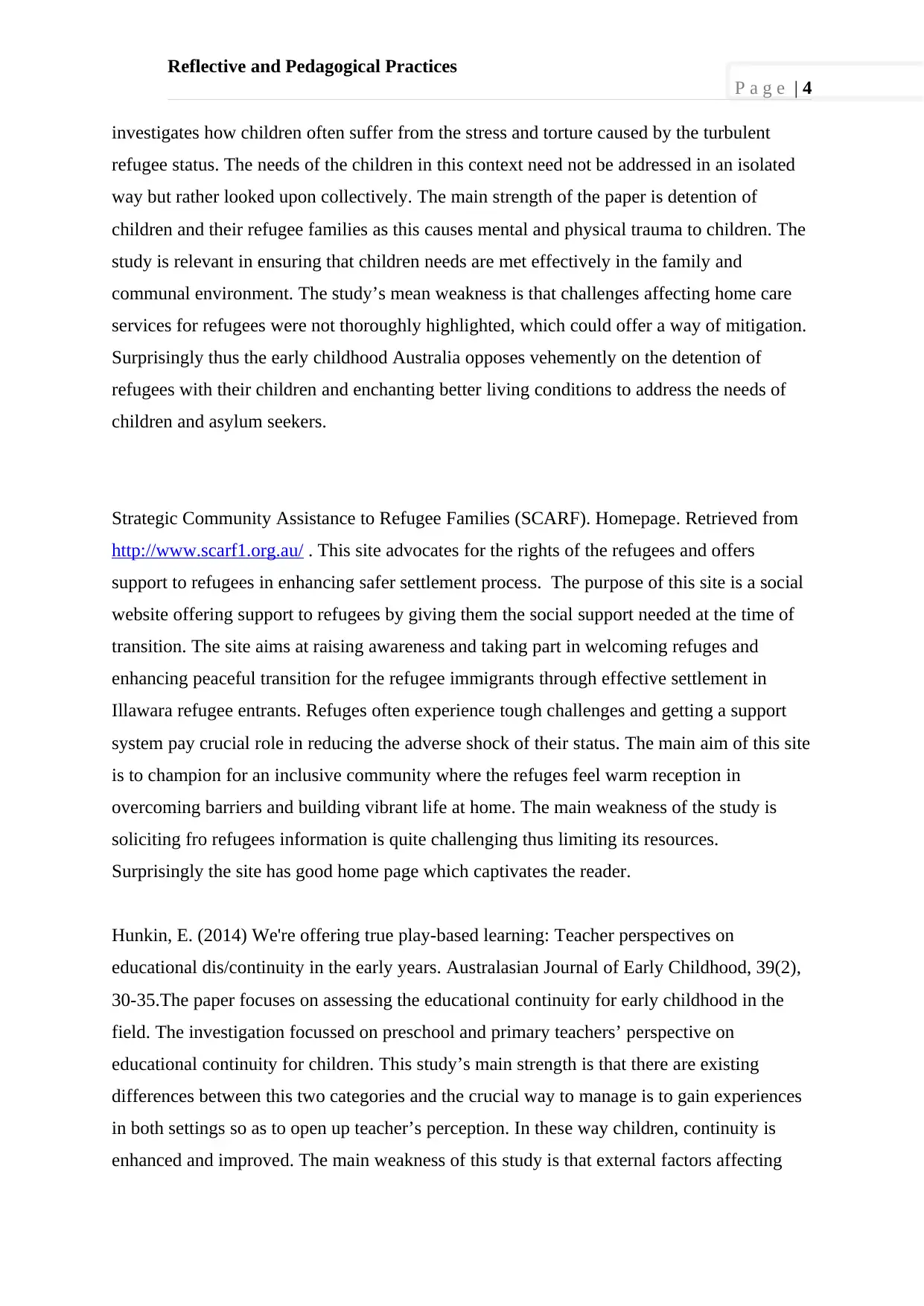
Reflective and Pedagogical Practices
P a g e | 4
investigates how children often suffer from the stress and torture caused by the turbulent
refugee status. The needs of the children in this context need not be addressed in an isolated
way but rather looked upon collectively. The main strength of the paper is detention of
children and their refugee families as this causes mental and physical trauma to children. The
study is relevant in ensuring that children needs are met effectively in the family and
communal environment. The study’s mean weakness is that challenges affecting home care
services for refugees were not thoroughly highlighted, which could offer a way of mitigation.
Surprisingly thus the early childhood Australia opposes vehemently on the detention of
refugees with their children and enchanting better living conditions to address the needs of
children and asylum seekers.
Strategic Community Assistance to Refugee Families (SCARF). Homepage. Retrieved from
http://www.scarf1.org.au/ . This site advocates for the rights of the refugees and offers
support to refugees in enhancing safer settlement process. The purpose of this site is a social
website offering support to refugees by giving them the social support needed at the time of
transition. The site aims at raising awareness and taking part in welcoming refuges and
enhancing peaceful transition for the refugee immigrants through effective settlement in
Illawara refugee entrants. Refuges often experience tough challenges and getting a support
system pay crucial role in reducing the adverse shock of their status. The main aim of this site
is to champion for an inclusive community where the refuges feel warm reception in
overcoming barriers and building vibrant life at home. The main weakness of the study is
soliciting fro refugees information is quite challenging thus limiting its resources.
Surprisingly the site has good home page which captivates the reader.
Hunkin, E. (2014) We're offering true play-based learning: Teacher perspectives on
educational dis/continuity in the early years. Australasian Journal of Early Childhood, 39(2),
30-35.The paper focuses on assessing the educational continuity for early childhood in the
field. The investigation focussed on preschool and primary teachers’ perspective on
educational continuity for children. This study’s main strength is that there are existing
differences between this two categories and the crucial way to manage is to gain experiences
in both settings so as to open up teacher’s perception. In these way children, continuity is
enhanced and improved. The main weakness of this study is that external factors affecting
P a g e | 4
investigates how children often suffer from the stress and torture caused by the turbulent
refugee status. The needs of the children in this context need not be addressed in an isolated
way but rather looked upon collectively. The main strength of the paper is detention of
children and their refugee families as this causes mental and physical trauma to children. The
study is relevant in ensuring that children needs are met effectively in the family and
communal environment. The study’s mean weakness is that challenges affecting home care
services for refugees were not thoroughly highlighted, which could offer a way of mitigation.
Surprisingly thus the early childhood Australia opposes vehemently on the detention of
refugees with their children and enchanting better living conditions to address the needs of
children and asylum seekers.
Strategic Community Assistance to Refugee Families (SCARF). Homepage. Retrieved from
http://www.scarf1.org.au/ . This site advocates for the rights of the refugees and offers
support to refugees in enhancing safer settlement process. The purpose of this site is a social
website offering support to refugees by giving them the social support needed at the time of
transition. The site aims at raising awareness and taking part in welcoming refuges and
enhancing peaceful transition for the refugee immigrants through effective settlement in
Illawara refugee entrants. Refuges often experience tough challenges and getting a support
system pay crucial role in reducing the adverse shock of their status. The main aim of this site
is to champion for an inclusive community where the refuges feel warm reception in
overcoming barriers and building vibrant life at home. The main weakness of the study is
soliciting fro refugees information is quite challenging thus limiting its resources.
Surprisingly the site has good home page which captivates the reader.
Hunkin, E. (2014) We're offering true play-based learning: Teacher perspectives on
educational dis/continuity in the early years. Australasian Journal of Early Childhood, 39(2),
30-35.The paper focuses on assessing the educational continuity for early childhood in the
field. The investigation focussed on preschool and primary teachers’ perspective on
educational continuity for children. This study’s main strength is that there are existing
differences between this two categories and the crucial way to manage is to gain experiences
in both settings so as to open up teacher’s perception. In these way children, continuity is
enhanced and improved. The main weakness of this study is that external factors affecting
Paraphrase This Document
Need a fresh take? Get an instant paraphrase of this document with our AI Paraphraser
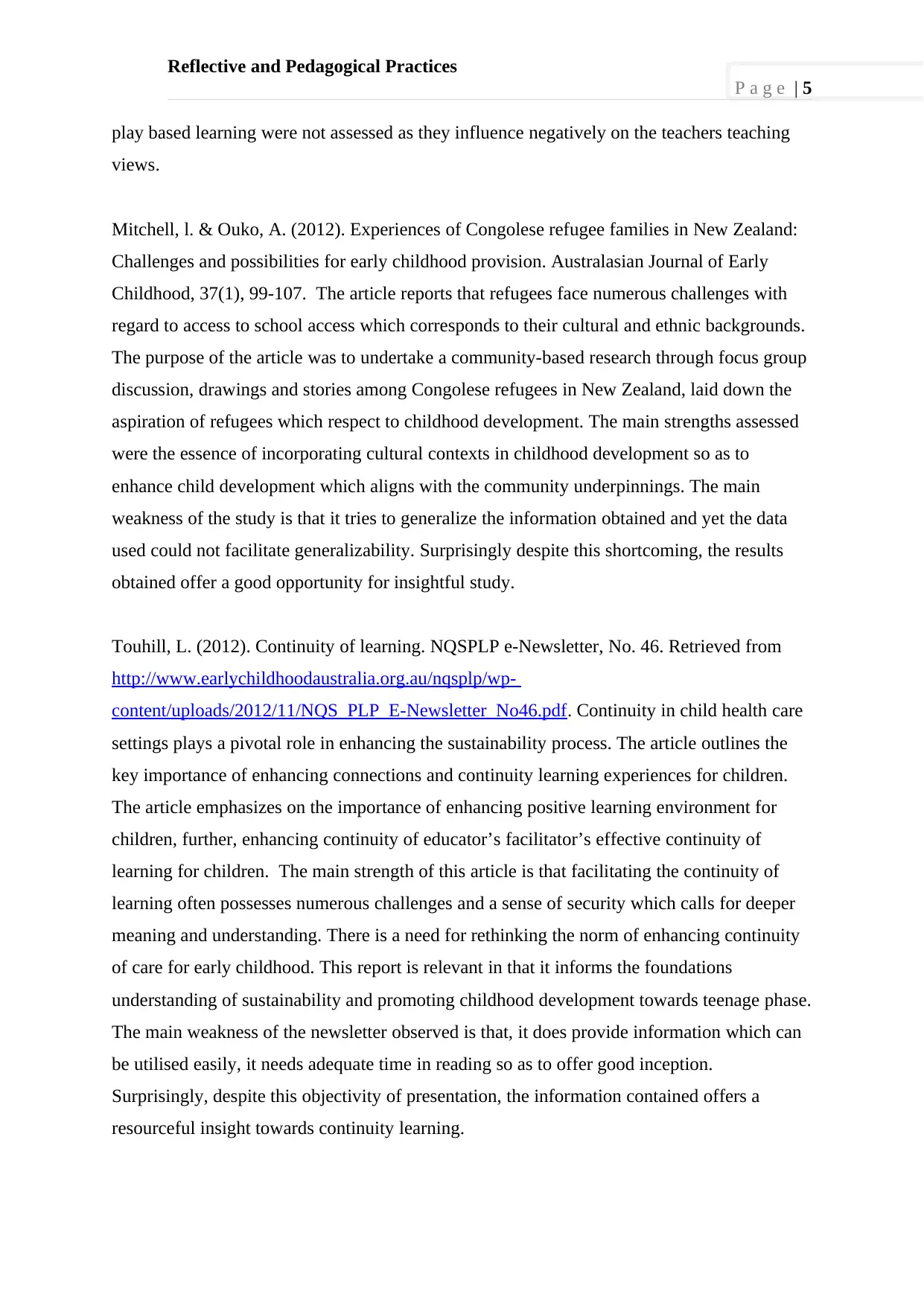
Reflective and Pedagogical Practices
P a g e | 5
play based learning were not assessed as they influence negatively on the teachers teaching
views.
Mitchell, l. & Ouko, A. (2012). Experiences of Congolese refugee families in New Zealand:
Challenges and possibilities for early childhood provision. Australasian Journal of Early
Childhood, 37(1), 99-107. The article reports that refugees face numerous challenges with
regard to access to school access which corresponds to their cultural and ethnic backgrounds.
The purpose of the article was to undertake a community-based research through focus group
discussion, drawings and stories among Congolese refugees in New Zealand, laid down the
aspiration of refugees which respect to childhood development. The main strengths assessed
were the essence of incorporating cultural contexts in childhood development so as to
enhance child development which aligns with the community underpinnings. The main
weakness of the study is that it tries to generalize the information obtained and yet the data
used could not facilitate generalizability. Surprisingly despite this shortcoming, the results
obtained offer a good opportunity for insightful study.
Touhill, L. (2012). Continuity of learning. NQSPLP e-Newsletter, No. 46. Retrieved from
http://www.earlychildhoodaustralia.org.au/nqsplp/wp-
content/uploads/2012/11/NQS_PLP_E-Newsletter_No46.pdf. Continuity in child health care
settings plays a pivotal role in enhancing the sustainability process. The article outlines the
key importance of enhancing connections and continuity learning experiences for children.
The article emphasizes on the importance of enhancing positive learning environment for
children, further, enhancing continuity of educator’s facilitator’s effective continuity of
learning for children. The main strength of this article is that facilitating the continuity of
learning often possesses numerous challenges and a sense of security which calls for deeper
meaning and understanding. There is a need for rethinking the norm of enhancing continuity
of care for early childhood. This report is relevant in that it informs the foundations
understanding of sustainability and promoting childhood development towards teenage phase.
The main weakness of the newsletter observed is that, it does provide information which can
be utilised easily, it needs adequate time in reading so as to offer good inception.
Surprisingly, despite this objectivity of presentation, the information contained offers a
resourceful insight towards continuity learning.
P a g e | 5
play based learning were not assessed as they influence negatively on the teachers teaching
views.
Mitchell, l. & Ouko, A. (2012). Experiences of Congolese refugee families in New Zealand:
Challenges and possibilities for early childhood provision. Australasian Journal of Early
Childhood, 37(1), 99-107. The article reports that refugees face numerous challenges with
regard to access to school access which corresponds to their cultural and ethnic backgrounds.
The purpose of the article was to undertake a community-based research through focus group
discussion, drawings and stories among Congolese refugees in New Zealand, laid down the
aspiration of refugees which respect to childhood development. The main strengths assessed
were the essence of incorporating cultural contexts in childhood development so as to
enhance child development which aligns with the community underpinnings. The main
weakness of the study is that it tries to generalize the information obtained and yet the data
used could not facilitate generalizability. Surprisingly despite this shortcoming, the results
obtained offer a good opportunity for insightful study.
Touhill, L. (2012). Continuity of learning. NQSPLP e-Newsletter, No. 46. Retrieved from
http://www.earlychildhoodaustralia.org.au/nqsplp/wp-
content/uploads/2012/11/NQS_PLP_E-Newsletter_No46.pdf. Continuity in child health care
settings plays a pivotal role in enhancing the sustainability process. The article outlines the
key importance of enhancing connections and continuity learning experiences for children.
The article emphasizes on the importance of enhancing positive learning environment for
children, further, enhancing continuity of educator’s facilitator’s effective continuity of
learning for children. The main strength of this article is that facilitating the continuity of
learning often possesses numerous challenges and a sense of security which calls for deeper
meaning and understanding. There is a need for rethinking the norm of enhancing continuity
of care for early childhood. This report is relevant in that it informs the foundations
understanding of sustainability and promoting childhood development towards teenage phase.
The main weakness of the newsletter observed is that, it does provide information which can
be utilised easily, it needs adequate time in reading so as to offer good inception.
Surprisingly, despite this objectivity of presentation, the information contained offers a
resourceful insight towards continuity learning.
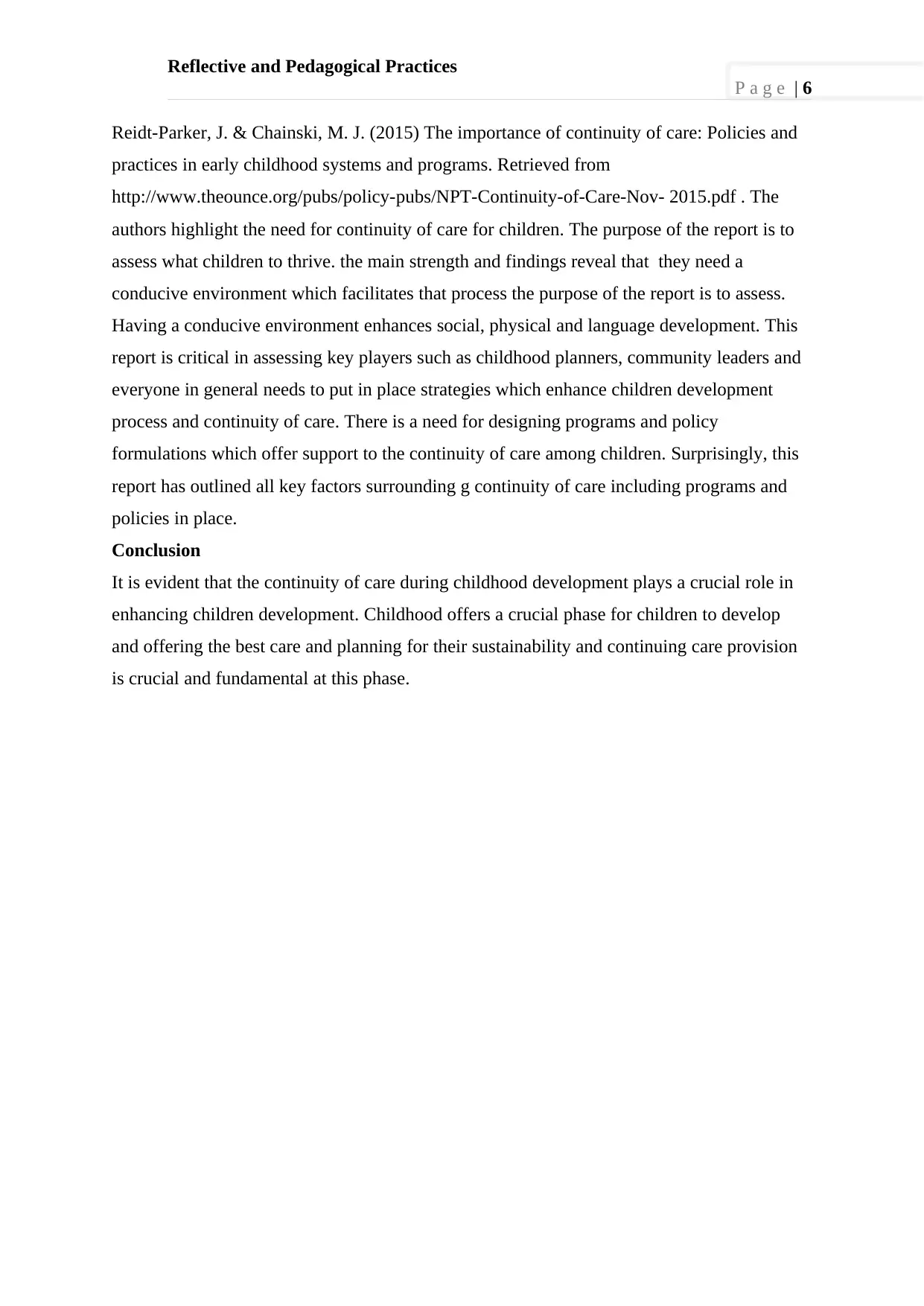
Reflective and Pedagogical Practices
P a g e | 6
Reidt-Parker, J. & Chainski, M. J. (2015) The importance of continuity of care: Policies and
practices in early childhood systems and programs. Retrieved from
http://www.theounce.org/pubs/policy-pubs/NPT-Continuity-of-Care-Nov- 2015.pdf . The
authors highlight the need for continuity of care for children. The purpose of the report is to
assess what children to thrive. the main strength and findings reveal that they need a
conducive environment which facilitates that process the purpose of the report is to assess.
Having a conducive environment enhances social, physical and language development. This
report is critical in assessing key players such as childhood planners, community leaders and
everyone in general needs to put in place strategies which enhance children development
process and continuity of care. There is a need for designing programs and policy
formulations which offer support to the continuity of care among children. Surprisingly, this
report has outlined all key factors surrounding g continuity of care including programs and
policies in place.
Conclusion
It is evident that the continuity of care during childhood development plays a crucial role in
enhancing children development. Childhood offers a crucial phase for children to develop
and offering the best care and planning for their sustainability and continuing care provision
is crucial and fundamental at this phase.
P a g e | 6
Reidt-Parker, J. & Chainski, M. J. (2015) The importance of continuity of care: Policies and
practices in early childhood systems and programs. Retrieved from
http://www.theounce.org/pubs/policy-pubs/NPT-Continuity-of-Care-Nov- 2015.pdf . The
authors highlight the need for continuity of care for children. The purpose of the report is to
assess what children to thrive. the main strength and findings reveal that they need a
conducive environment which facilitates that process the purpose of the report is to assess.
Having a conducive environment enhances social, physical and language development. This
report is critical in assessing key players such as childhood planners, community leaders and
everyone in general needs to put in place strategies which enhance children development
process and continuity of care. There is a need for designing programs and policy
formulations which offer support to the continuity of care among children. Surprisingly, this
report has outlined all key factors surrounding g continuity of care including programs and
policies in place.
Conclusion
It is evident that the continuity of care during childhood development plays a crucial role in
enhancing children development. Childhood offers a crucial phase for children to develop
and offering the best care and planning for their sustainability and continuing care provision
is crucial and fundamental at this phase.
You're viewing a preview
Unlock full access by subscribing today!
1 out of 6
Related Documents
Your All-in-One AI-Powered Toolkit for Academic Success.
+13062052269
info@desklib.com
Available 24*7 on WhatsApp / Email
![[object Object]](/_next/static/media/star-bottom.7253800d.svg)
Unlock your academic potential
© 2024 | Zucol Services PVT LTD | All rights reserved.




